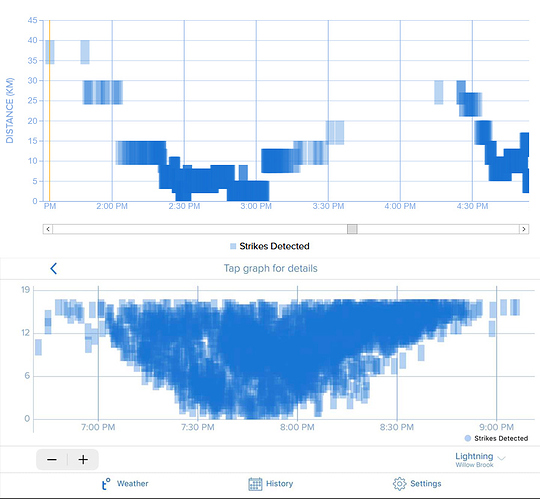I have the air and sky units. We had lighting but my station being the air and sky didn’t detect as much lightning as 2 stations a few blocks away. Are they getting better lightning detection because tempest units have it built in the unit and the units are higher up than the older air?
Station 8254. Take a look I’m in between 2 stations august 12th around 5am attached photos to show
something might be wrong with the Air unit. it is supposed to give you its own measured data. Keep in mind that the sensor in both Air and tempest only reports strikes at the leading edge of the storm. For tempest users, the graph is filled with data from third party sources.
It would be nice to see the third party data marked differently and plot them as dots instead of bars.
I might be interested in getting tempest. Can someone contact me?
order one on their website if you are in the usa. https://shop.weatherflow.com/collections/frontpage/products/tempest outside the usa you will have to wait, but it will come
I wasn’t aware of this. That’s a useful piece of information!
The has been performing well. Actually, I’ve not really watched it too much this year, but will start paying attention to Lightning from both now…
Why is it only the front of the storm?
it is in the specs of the chip. probably because it is used to warn people that the storm is getting nearer https://cdn.sparkfun.com/assets/learn_tutorials/9/2/1/AS3935_Datasheet_EN_v2.pdf look at figure 17 on page 13
Peter, that is not accurate. Once the storm is overhead It will still detect strikes within a 40 km distance. It doesn’t matter which direction the storm is moving.
Well now I don’t know what to believe! 
What does logic tell you. Read the information in the document. Then check your own station data from a storm. Then ask yourself, “Is that logical for a lightning detection device?” And does the document actually state it only detects the leading edge?
You can see what it detects, the strikes are a U shape as it approaches, passes over head, and moves away. At least thats what my Air’s show when it comes over head 
From todays storm:

One thing I have noticed is my indoor air has lightning disabled, and it didn’t report strikes. But ever since the Tempest system came online, it also started reporting them. I assumed this was because they were in-fill from the 3rd Party sources used on the Tempest (I can not see any reason why the 3rd party data can not be reported for users with an Air, its not like the data has anything to do with the device at the users end, when its coming from the WF backend). But if that is not the case, then I seem to have found a bug?
I totally agree. It seems like tempest lightning detectors are on people’s roofs opposed to the air at 5 to 6 feet on the ground. Of course being at that height of 25 to 30ft u will detect lightning much farther. This data needs to be brought to original air units
Regardless of height the range is at 40 km.
You may be right Gary, but why the difference of the 2 graphs of lightning from 2 weather stations 5 blocks apart. 1 tempest and 1 air. Unless its a software difference. Just boggles my mind
I can’t answer to that. @WFstaff will have to explain the difference. I know there has been an issue with the firmware concerning the Tempest and lightning but I don’t have the details.
Well, yes:
“The AS3935 can detect the presence of an approaching storm with lightning activities and provide an estimation of the distance to the leading edge of the storm…”
(this is from page 13 of the datasheet @sunny shared), and this description agrees with the graphical representation in Figure 17. Now the question is, is what is the “leading edge”? The datasheet goes onto to say:
“… where the leading edge of the storm is defined as the minimum distance from the sensor to the closest edge of the storm”.
So it is quite possible to interpret this as the trailing edge essentially becomes the “leading edge” when the storm has passed overhead. Unfortunately we don’t get enough lighting in the UK to really test this, hence my unfamiliarity.
indeed that’s the case. Here you can see a typical storm reported by Air and one by Tempest. (not the same storm)
the sensor doesn’t know the direction of the storm. It does what it does. And yes, we humans might call it the trailing edge, because we know the direction of the storm.
it IS a software difference.






